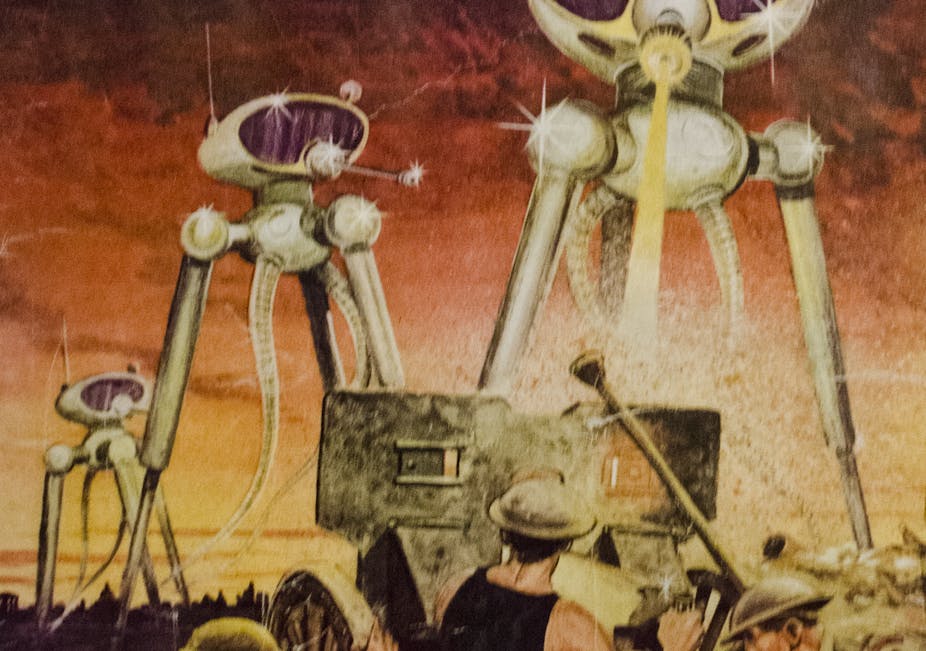Has a book been found on Mars? One enthusiast trawling the NASA photo archives thought so. Of course, it turns out it’s just a rock – a rock that appeared to look exactly like a book in one particular picture.

Still, with the Mars One mission down to the final 100 candidates (out of more than 200,000 applicants) to make it through to the third round of their global astronaut selection programme, it’s not surprising that the prospect of life on Mars is uppermost in our minds. If all goes to plan, human settlement on the red planet could be underway by 2024, and with that comes the very real possibility of a book from Mars.
For those who make the final cut, it’s hoped they’ll not only write routine reports, but also give the people back home on Earth some insight on what it’s like to live on Mars. Among these first generations of settlers might be our first Martian author.
So what might they write about? And will it put the science fiction we currently read in the shade? As the crew tell Arthur C Clarke’s novelist protagonist in The Sands of Mars (1951), once space travel and planetary colonisation become scientific fact, science fiction risks becoming obsolete.
For the present though, science fiction offers some clues as to the form a book from Mars might take. H G Wells’s monumental The War of the Worlds (1898) is perhaps the first novel that springs to mind when we think of Martians. But there’s a rich array of novels and short stories imagining not only Martian invaders, but also journeys to Mars and what life on Mars might be like.
As early as 1880, Percy Greg’s Across the Zodiac envisaged a traveller journeying to Mars in a specially engineered vessel, an “astronaut”, powered by an anti-gravitational substance called “apergy”. Greg’s traveller finds a Martian civilisation which he marries into, but tragedy and revenge force him to return to Earth where he apparently crash lands with only his metal-bound manuscript to survive him. It’s this same narrative strategy of the surviving manuscript that Edgar Rice Burroughs deploys to relate John Carter’s teleportation to Barsoom in The Princess of Mars (1917), the first of an 11-book series, which Disney brought to our screens in 2012.
So perhaps then travelogues and survival stories will inspire the first Martian fiction. After all, Daniel Defoe’s Robinson Crusoe (1719), one of the earliest novels in the English language, was written similarly at a time of burgeoning travel and colonial conquest. The very form of Robinson Crusoe – spiritual autobiography and adventure story – celebrates the individual’s triumph over isolation and environmental adversity. No wonder then that we’ve seen Defoe’s novel translated into fictionalised human exploits on other planets.
The most recent of these is Andy Weir’s 2011 novel, The Martian, a gripping story of survival in a hostile world. It looks back to Rex Gordon’s No Man Friday (1956) in which Gordon Holder, a butcher’s son from Manchester and lone survivor shipwrecked on Mars must devise ways to distill potable water, find food and keep warm in an atmosphere where he cannot make fire. Holder even sees himself “as a latter-day Crusoe”:
Instead of a goatskin coat, a parasol, a gun over my shoulder, and a parrot on my arm, I wore an oxygen mask and carried a microscope and a collecting box for specimens.
But, as Gordon’s title suggests, it’s the “Man Friday” of this tale that captivates us – a highly intelligent whale-like creature that speaks through light waves – which is both superior to mankind and yet still vulnerable to exploitation.
Gordon’s Martian natives join a menagerie of creatures conjured up by science fiction. Burroughs’s John Carter notes that the “fauna of Mars” characteristically have a “multiplicity of legs”, while Clarke’s space-travelling novelist, Martin Gibson, in The Sands of Mars accidentally discovers a native species that looks like “plump kangaroos”. Often the Martians of our imagination are distinctly humanoid, even to the extent that Mary, the narrator of Naomi Mitchison’s Memoirs of a Spacewoman (1962) has a baby by one – the accidental result of tactile communication since Mitchison’s Martians rarely use speech and vacillate between sexes.
There’s a very good chance a book from Mars will dispel all our expectations of alien life. And it might indeed herald the demise of science fiction as Clarke predicts. But in the meantime, our science fiction writers give us plenty of food for thought.
With a cautionary eye on imperial history and post-colonial legacies, Mitchison, for example, asks some searching questions. Her space explorer crosses galaxies to communicate with other life forms, only to find herself doubting humanity’s motives. “Perhaps in another dozen generations or so,” she muses, “we shall get to the point where we feel it is wrong to commit even the interference of being in an alien world”. And you know, perhaps she’s right.

